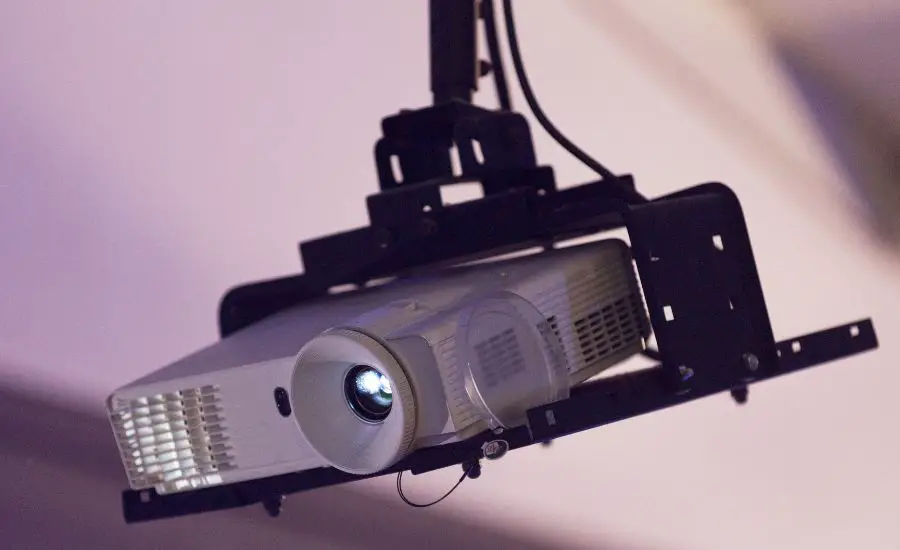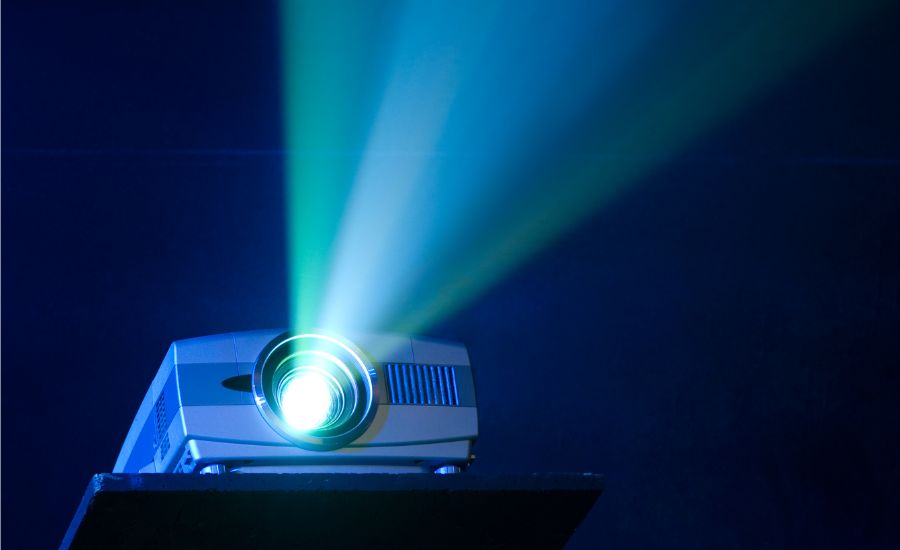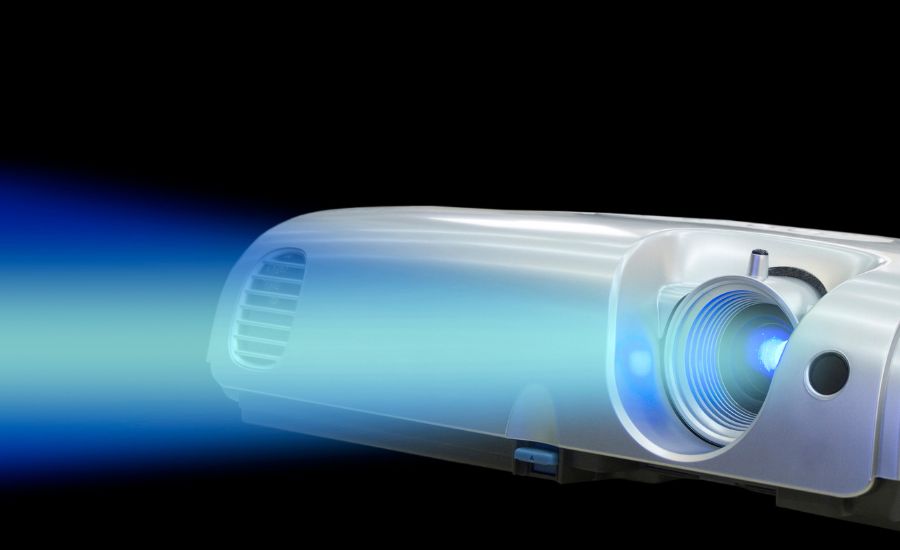LED vs laser projector? Projectors have become an essential tool for a variety of applications, from business presentations to home entertainment. Two prominent types of projectors that have gained traction in recent years are LED projectors and laser projectors. From another point of view, a lamp-based projector and a DLP projector are distinct but interconnected concepts of projection technology.
Both technologies offer different advantages and drawbacks, making the choice between them crucial for users seeking optimal performance for their specific needs.

Importance of choosing the right projector technology
Choosing between LED or laser projector technologies is an important decision that depends on your specific needs.
LED projectors
LED projector stands for light-emitting diodes. LED projectors typically use a combination of red, green, and blue laser chips to create light.
Unlike traditional projectors, where light is generated by heating lamps, LED projectors emit light directly when electric current passes through them.
This direct emission of white light source results in less heat and several advantages for digital projectors, too.

Image quality and color accuracy
LED projectors are known for providing good image quality and color accuracy.
An LED projector can produce a wide range of primary colors and offer consistency. They use a combination of red, green, and blue LED lights to create images.
Lamp-based projectors often use RGB primary colors (red, green, blue) color sources to create full-color images.
This makes an LED projector suitable for applications where color accuracy is important, such as presentations involving graphics, design work, and multimedia content.

Brightness capabilities
An LED projector comes in laser models with various brightness levels, typically measured in lumens. While they might not achieve the same extreme brightness primary color level blue laser show as some laser projectors, they are still capable of providing blue colors for smaller and medium-sized screens. Lamp-based projectors are suitable for smaller screens.

The lifespan of LED projectors
One of the significant advantages of using LED bulbs and projector lamps is their long lifespan.
LED bulbs can last anywhere from 20,000 to 50,000 hours or even more, depending on the manufacturer and usage.
This longevity translates to years of use of replacement lamps without needing frequent bulb replacements.
As a result, maintenance costs are reduced compared to traditional lamp projectors, which require more frequent bulb changes.

Energy efficiency and environmental impact
Unlike lamp-based projectors, LED in projector lamps are highly energy efficient.
They require less power to produce the same level of high brightness as traditional lamp-based projectors.
This energy efficiency not only reduces operational costs but also has a positive environmental impact by lowering energy consumption and greenhouse gas emissions.
Cost considerations
While an LED projector can have higher costs than a basic one, a lamp-based projector often provides better long-term value due to its extended lifespan and reduced maintenance needs.
The initial investment might be higher, but over the front projector lamp’s lifetime, you will save on LED bulb replacements and associated labor costs.

Laser projectors
A laser projector uses laser light sources to make light source produce images.
They typically employ red, green, and blue lasers that pass through a color wheel or combine to create images with a full spectrum of primary colors.
Unlike traditional lamp projectors, laser projectors do not require heating elements and provide consistent light emission, resulting in various advantages.

Image performance and color reproduction
Laser projectors often deliver superior image accuracy and color performance compared to other technologies. A projector light source is crucial.
The use of laser projectors allows for precise control over color accuracy and saturation, resulting in vibrant and lifelike visuals.
They employ laser light sources, which can deliver a wide color gamut and better control over brightness levels.
This makes a laser projector suitable for applications where color performance is critical, such as presentations involving detailed images or video content.
Brightness compared to LED projectors
Laser projectors are known for their high-brightness capabilities. They can produce significantly brighter images compared to many LED projectors.
This makes them well-suited for larger screens, well-lit environments, and venues where a strong visual presence is crucial.

Longevity and reliability of laser projectors
Laser projectors offer impressive longevity and reliability. At the same time, their lifespan is generally shorter than what an LED projector offers.
Laser projectors can typically last around 20,000 to 30,000 hours before experiencing significant brightness reduction. Unlike lamp-based projectors, laser projectors don’t need frequent lamp replacements.
Energy efficiency in laser projectors
Laser projectors are energy efficient, especially when compared to a lamp projector.
They use less power to generate high brightness levels, making them a sustainable choice for applications that require light without energy consumption.
Investment and maintenance costs
Laser projectors often come with a higher investment compared to traditional lamp projectors or even some LED projectors.
However, their long lamp life and lower maintenance needs compensate for these higher initial costs over time.

Comparing LED and laser projectors: making the right choice
In the realm of visual technology, the choice between LED lights and laser projectors can be both exciting and overwhelming.
LED and projector light sources offer numerous benefits over lamp projectors, including light sources with higher energy efficiency, a longer lifespan, and consistent light output.
On the other hand, lamp projectors have been a staple for years, with their reliance on the lamp-based projector screen light source of incandescent bulbs or newer technologies like laser projection screens. Also, lamp projectors are advanced lamp-free projectors.
Incandescent bulbs are a traditional type of light source that was commonly used in older projectors, but now they are not common.
A projector lamp uses high-intensity discharge technology.
Laser projectors require precision and accuracy in their designs, and their light source is more concentrated.
To make an informed decision, it’s essential to delve into the aspects of image quality, brightness, longevity, and cost.
Image quality and performance
When the RGB laser projector meets the projection screen, the result is a visual masterpiece. Moreover, several factors contribute to excellent image quality and an immersive experience:
- Contrast ratio and black levels: the choice of the projector lamp as a light source has a significant impact. Both LED or laser projectors boast impressive contrast ratios, which translate into deep black levels and image performance. A laser projector, with its advantages and technology, elevates the visual experience even further.
- Color gamut coverage: the range of colors a projector can reproduce is critical. Laser projectors, with their precise color modulation, offer wider color gamuts.
- Resolution options: a lamp projector offers various resolution options. Whether you opt for Full HD(1080p),4K, or beyond, both LED and laser projectors provide various resolution choices for your needs.
- Handling of motion: both technologies exhibit minimal motion blur, ensuring seamless visuals even during action-packed sequences. RGB laser projectors excel in this arena, capturing the nuances of movement with breathtaking accuracy.

Brightness and projection environments
Luminosity takes center stage when discussing projection environments:
- Lumens as a measure of brightness: Lumens serve as a unit of measurement for brightness. The higher the lumens, the more suitable the projector is for larger screens and well-lit settings.
- LED vs. laser brightness output: laser projectors typically outshine their LED counterparts in terms of brightness output. This advantage becomes particularly apparent at larger venues and outdoor events.
- Adaptability to different room lighting conditions: both LED and laser projectors offer adaptability to diverse room lighting conditions, but laser projectors are more capable in brighter environments.
- Impact of ambient light on image quality: the presence of ambient light can influence image accuracy. Here, laser projectors shine with their robust brightness, mitigating the effects of ambient light and maintaining picture quality.
Lifespan and durability
Longevity and durability are key factors for cost-effective solutions:
- Expected lifespan: LED projectors stand out with their remarkable lifespan, ranging from 20,000 to 50,000 hours. Laser projectors, while slightly shorter-lived (around 20,000 to 30,000 hours), still offer durability.
- Factors affecting longevity: usage patterns, operating conditions, and maintenance practices play a role in determining the lifespan of a projector light source.
- Maintenance requirements and costs: both technologies demand minimal maintenance, yet laser projectors have a slight edge due to their reduced component count.
- Performance consistency over time: both LED and laser projectors maintain consistent performance over an extended period. However, laser projectors exhibit better brightness retention over time compared with lamp-based options.
Energy efficiency and environmental impact
Energy efficiency and environmental considerations shape the modern technological landscape:
- Energy consumption of LED vs. laser projectors: LED projectors stand out as energy-efficient options, consuming less power compared to laser projectors.
- Heat generation and cooling systems: while laser projectors can generate more heat, their cooling systems manage this effectively.
- Eco-friendly aspects of each technology: both LED and laser projectors offer eco-friendly features compared to traditional projectors.
- Carbon footprint comparison: due to their lower energy consumption, LED projectors often have a smaller carbon footprint.

Cost considerations
Cost is a critical and major factor influencing decision-making:
- Initial purchase of LED and laser projectors: LED projectors generally offer a more budget-friendly option compared to laser projectors. LED projectors ultimately have a lower upfront cost compared to a laser projector, making them an attractive option for budget-conscious consumers.
- Total cost of ownership over the lifespan: while laser projectors might have higher costs, they often provide better long-term value due to lower maintenance requirements and an extended lifespan. What’s more, laser projectors not only offer a prolonged lifespan but also require minimal upkeep.
- Factors influencing cost-effectiveness: cost considerations play a big role when it comes to choosing a lamp projector, but various factors, including usage patterns, energy prices, and maintenance costs, affect the overall cost-effectiveness of a projector choice.
- Value proposition for different user scenarios: the value proposition of each technology depends on the user’s priorities and the specific application. Whether the budget-friendly LED projectors or the longevity-oriented laser projector, the choice aligns with the user’s needs.
- Balancing cost with long-term value: laser projectors, despite their higher initial cost, often provide better value over time due to their longer lifespan and reduced maintenance needs. Conversely, LED projectors might have a lower upfront cost but lead to higher maintenance costs and more frequent bulb replacements over their lifespan.
Application scenarios
Different scenarios demand distinct projector solutions:
- Business and professional use cases: both LED and laser projectors find their place in business settings, such as presentations and enhanced visuals. LED projectors, with their color performance, ensure that your visual resonates with precision. On the other hand, laser projectors shine brilliantly in larger venues.
- Home theater and entertainment environments: educational settings benefit from both technologies, with laser projectors serving larger audiences more effectively. If you’re seeking a compact setup or projecting in a smaller room, an LED projector is an excellent fit. However, if you’re aiming for a full-fledged home theater experience with larger screens, laser projectors are your answer.
- Large venue and event projection: the high output of laser projectors makes them ideal for large events and outdoor projections. Laser projectors dominate here. From live concerts to outdoor gatherings, laser projectors have the power to captivate vast audiences. Their ability to combat light sources and maintain vivid visuals ensures that your message or content reaches every corner.

Read also: What Kind of Projectors Do Movie Theaters Use?
FAQs
Which is better: LED or laser projector?
The question of whether LED or laser projectors are better depends on your specific needs and preferences. Both technologies have their advantages and considerations.
Are laser projectors better?
Laser projectors often provide superior image quality, brightness, and color accuracy compared to a lamp projector or LED projectors. However, “better” is subjective and depends on the specific requirements of your intended use.
What is the difference between lamp LED and laser projector?
LED projectors utilize light-emitting diodes as the light source. They offer better energy efficiency, longer lifespans, and consistent color performance.
Laser projectors use laser diodes as the projector lamp’s primary light source. They offer higher brightness, wider color gamuts, and better color accuracy.
Is laser projector better than LCD projector?
Laser projectors and LCD projectors refer to different aspects of projectors. An LCD projector refers to the display technology, while a laser projector refers to the light source technology. A laser projector can provide better advantages compared to a back lamp projector-based projector or a projector-based LCD projector.
Conclusion
In the LED vs. laser projector debates, there’s no one-size-fits-all answer. Each technology boasts its strengths, offering tailored solutions for diverse scenarios.
From the extended lifespan of LED projectors to the remarkable brightness of laser projectors, the choice ultimately rests on your unique needs, preferences, and intended usage.
